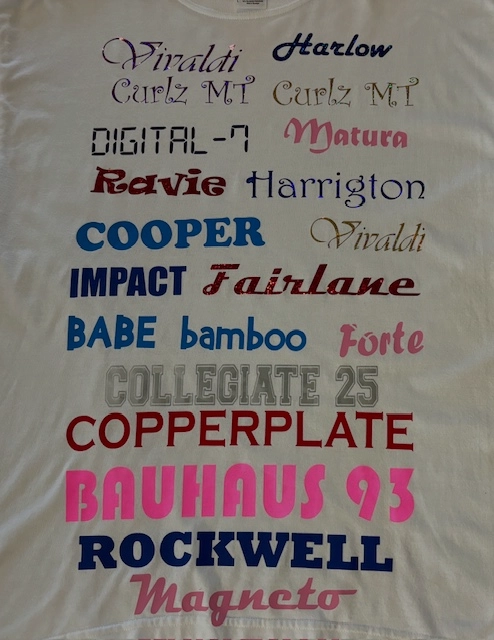Customized Scrubs with Embroidery for an Expert Appearance
Customized Scrubs with Embroidery for an Expert Appearance
Blog Article
The Art of Custom-made Needlework: Opening the Tricks to Creating Special and Memorable Designs
The tricks to developing customized needlework designs that captivate the eye and leave an enduring perception lie in a delicate equilibrium of technique, creative thinking, and interest to information. As we dig right into the world of custom needlework, we discover the nuanced interplay in between string option, stitch complexity, and design personalization that boosts a simple garment to a job of art.
Selecting the Right Embroidery Threads
When selecting embroidery strings, what key variables should you consider to make sure the best results for your personalized styles? The selection of embroidery thread is vital in identifying the last end result of your embroidered design. Among the key considerations is the material of the thread. Various products such as cotton, polyester, rayon, and silk offer varying levels of luster, resilience, and structure. It is necessary to select a thread material that complements the material you are embroidering on and straightens with the wanted look of the design.
Furthermore, the weight or thickness of the thread plays a considerable role in the look of the needlework. Thicker strings can include measurement and texture to your style, while finer strings are suitable for complex information and little text. Furthermore, thinking about the color fastness and washability of the thread is essential to ensure that your custom styles maintain their quality and vibrancy over time. By carefully evaluating these aspects and choosing top quality threads that fulfill your certain needs, you can boost the aesthetic appeal and longevity of your stitched developments.
Exploring Different Stitch Methods
To look into the realm of 'Checking out Various Stitch Techniques', one should comprehend the complexities and nuances that each stitching method brings to the art of needlework. Different stitch strategies not only include aesthetic passion however additionally contribute to the total structure and dimension of the style. One popular stitch method is the satin stitch, which entails closely stuffed parallel stitches to produce a smooth and glossy surface, suitable for loading in shapes and producing vibrant lays out.
On the other hand, the backstitch is a flexible strategy typically used for outlining and adding fine information. It entails stitching backwards to create a solid line of needlework. In addition, the French knot stitch adds a tactile aspect to layouts, ideal for producing distinctive accents like blossom facilities or decorative touches.
Discovering various stitch techniques allows embroiderers to play with light, shadow, and deepness within their styles, raising the visual charm and imaginative quality of their needlework tasks. By grasping numerous sewing techniques, one can open limitless opportunities for developing distinct and unforgettable custom-made needlework items.
Incorporating Personalized Design Aspects
Having checked out the details of various stitch strategies such as the satin stitch, backstitch, and French knot, the focus now changes in the direction of including personalized style elements in custom embroidery tasks. Customized style aspects play an important function in making embroidery tasks really unique and unforgettable.
Another way to integrate customized style aspects is by including symbols or motifs that hold special definition to the recipient or show their rate of interests and character. Including a favorite blossom, animal, or hobby-related sign can make the needlework design more significant and individualized. Furthermore, choosing shades that resonate with the recipient or line up with the desired theme can better enhance the customization of the embroidery job.
Mastering the Art of Shade Control

One secret facet of color coordination is understanding shade concept. This includes recognizing how various colors engage with each various other, the feelings they communicate, and just how they can be integrated to produce visually appealing designs. By applying shade theory concepts, embroiderers can create unified shade schemes that boost the general appearance of the design.
Furthermore, paying focus go right here to comparison is crucial in shade control. Using contrasting shades can assist certain components of the style pop, boost readability, and create a visually vibrant needlework piece. By mastering the art of shade sychronisation, embroiderers can boost their layouts and create unforgettable pieces that resonate with customers and visitors alike.
Enhancing Structure With Advanced Needlework Stitches
French knots, for example, are ideal for including little, elevated dots to your layout, simulating the appearance of grains or developing a distinctive surface area. Bullion knots, on the other hand, can be made use of to produce twisted, ropelike aspects that include a glamorous feeling to the needlework. Seed sewing involves little, scattered stitches that can fill out locations with a speckled texture, while turkey work develops fluffy, dimensional accents evocative pet hair or vegetation. Explore these innovative needlework stitches enables you to push the boundaries of traditional embroidery and create truly unique and aesthetically attractive textures in your designs.
Final Thought
To conclude, the art of custom-made embroidery involves a mix of choosing the appropriate strings, exploring numerous stitch strategies, integrating personalized design aspects, mastering shade control, and improving appearance with advanced stitches. By comprehending and executing these key components, embroiderers can create one-of-a-kind and unforgettable styles that display their creativity and skill. image source Embroidery enthusiasts can unlock the secrets to producing lovely and custom items that stick out and leave a lasting impact.
Report this page